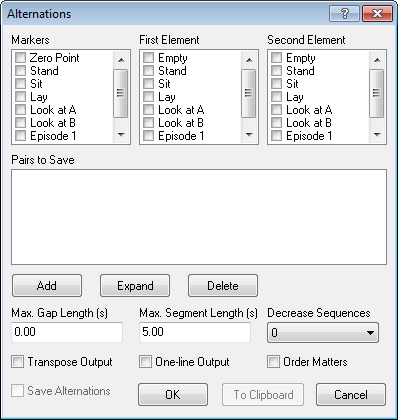
Contents - Index - Previous - Next
Alternations
Alternations calculates the number of alternations between two elements (e.g. gaze alternation). The settings for calculating alternations can be set by clicking on Analyze \ Alternations.

The desired output can be set similar as described in Starting to Analyze but here pairs of elements have to be defined and there are also some additional options too.
After selecting the appropriate marker from the Markers checklist box a pair of elements has to be selected from the First Element, Second Element checklist box. Then by clicking on Add the selected marker and the pairs will be added to the Pairs to Save list. One marker can be added only once to the Pairs to Save list. More pairs can be added to a certain marker by selecting the desired new pair from the First Element and the Second Element checklist boxes, then selecting the appropriate line containing the marker in the Pairs to Save list and finally pressing Expand.
Max. Gap Length (s): The maximum length of a "gap" (section of the coding sheet not containing any of the two selected elements) where the program considers the two elements still adjacent.
Max. Segment Length (s): If one of the two elements has a continuous section longer than the value defined here then the program will treat the actual sequence of alternations terminated.
Decrease Sequences: The number by which each individual sequence of alternations should be decreased.
Order Matters: Makes it possible to calculate separately the cases when B follows A and when A follows B. To obtain the result for both cases A has to be selected as a First Element and B as a Second, then added to the Pairs to Save list. Then B selected as a First Element and A as a Second, then added to the pairs to Save list to the same marker.
Output can be obtained as described in Saving and Exporting Analyzed Output.